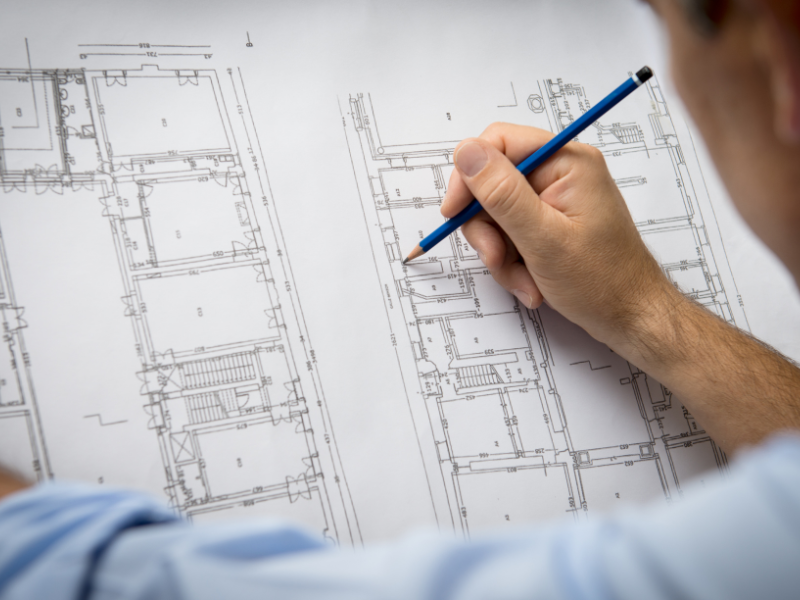Architect Firm Marketing Strategies That Deliver Results
Architect Firm Marketing Strategies That Deliver Results
Blog Article
Understanding the Diverse Career Paths Available for Aspiring Architect
As an aspiring Architect, you have a globe of job courses awaiting you. Each path offers special obstacles and possibilities to apply your creative thinking and technical know-how. Whether you're drawn to traditional architecture or the subtleties of sustainable design, there's a particular niche that straightens with your rate of interests. Understanding these varied options can shape your specialist trip, yet which instructions will you pick to discover initially?
Conventional Architecture: Designing Buildings and Structures
Standard design focuses on making structures and structures that mix performance with visual allure. Your layouts can reflect social heritage, showcasing local practices while meeting modern-day demands.
You'll create abilities in drafting, model-making, and website evaluation, permitting you to imagine and communicate your ideas efficiently. Involving with clients, you'll require to understand their vision and convert it into feasible designs.
Furthermore, constructing codes and sustainability techniques are important in your work, guaranteeing your structures are ecologically pleasant and secure. As you expand in your career, you'll find opportunities in residential, commercial, or even remediation tasks, each offering unique obstacles. Welcoming typical style leads the way for a meeting job that pays homage to the past while shaping the future.
Urban Planning: Shaping Communities and Public Spaces
As an aspiring Architect, you can play a necessary duty as an urban coordinator, transforming how communities work and communicate. By utilizing community interaction techniques, you'll guarantee that locals have a voice fit their atmosphere. Plus, incorporating lasting design concepts will certainly aid develop rooms that not only satisfy today's demands yet also secure the future.
Role of Urban Planners
While numerous could think about engineers as the single dreamers behind structures, urban organizers play a necessary role in forming the wider landscape of neighborhoods and public rooms. They assess land use, zoning laws, and community needs to create lasting environments that improve lifestyle. By teaming up with numerous stakeholders, you'll assist develop parks, transportation systems, and domestic areas that advertise social communication and ease of access. Urban coordinators additionally concentrate on ecological factors to consider, guaranteeing that advancements integrate eco-friendly rooms and assistance biodiversity. Your know-how in spatial style and community dynamics permits you to visualize future development while maintaining social heritage. In this crucial role, you'll directly affect how individuals experience their surroundings, making every job a chance for favorable change.
Area Interaction Techniques
Efficient neighborhood interaction approaches are vital for urban planners to assure that the voices of homeowners are listened to and valued in the planning procedure. To cultivate purposeful dialogue, you ought to prioritize open online forums and workshops where area participants can share their ideas and concerns. Usage surveys and social networks to get to a more comprehensive audience, making certain varied perspectives are consisted of. Collaborating with local organizations can enhance depend on and help with much deeper links. It is necessary to provide clear information about suggested projects and decision-making processes, enabling citizens to really feel informed and equipped. By actively listening and incorporating responses, you'll develop spaces that mirror the community's needs, inevitably leading to more successful and sustainable metropolitan environments. Accept openness and continual discussion for lasting effect.
Sustainable Design Concepts
When designing city spaces, integrating sustainable design principles is critical for developing settings that thrive both ecologically and socially. Consider integrating green rooms, like yards and parks, to boost biodiversity and improve air high quality.
Designing with water preservation in mind is also crucial-- think of rain yards and permeable surfaces to take care of stormwater. Including community members during the planning procedure guarantees that the rooms you create meet their demands and urge social interaction. By embracing these principles, you'll add to dynamic, sustainable metropolitan landscapes that benefit everybody.

Landscape Architecture: Creating Lasting Outside Environments
As you explore landscape architecture, you'll uncover important design concepts that produce functional and gorgeous outdoor areas. Lasting methods play a vital duty in ensuring these environments grow while reducing ecological effect. And also, you'll discover a selection of career chances that allow you to make a genuine difference in exactly how individuals interact with nature.
Style Concepts in Landscape
Comprehending style principles in landscape architecture is important for developing lasting outside settings that integrate with nature. You'll require to contemplate components like percentage, scale, and equilibrium to guarantee your designs feel natural and welcoming. Integrating indigenous plants not just improves biodiversity however likewise minimizes water use, making your landscape resilient. Believe about the circulation of room and just how individuals communicate with it; paths and seating areas ought to invite expedition and leisure. In addition, take notice of seasonal modifications, creating with materials that enhance the environments year-round (Architect). By prioritizing sustainability and aesthetic appeals, you can develop outdoor areas that enrich the community and promote well-being. Accepting these concepts will set a solid structure for your career in landscape style.
Lasting Practices Summary
Lasting methods in landscape design not only concentrate on aesthetic appeals but also focus on environmental health and resource preservation. By integrating indigenous plants, you enhance biodiversity and decrease the demand for chemical plant foods and pesticides. Implementing effective watering systems aids save water and reduces drainage, protecting nearby ecological communities. You can make spaces that promote dirt health, such as utilizing natural materials and practicing permaculture concepts. In addition, integrating eco-friendly infrastructure, like rain yards and porous sidewalks, aids in stormwater monitoring and minimizes metropolitan heat. When you create outdoor atmospheres with sustainability in mind, you contribute to a healthier planet and give areas that promote neighborhood connection. Eventually, these practices assure your styles profit both people and the environment for many years to find.
Occupation Opportunities Exploration
With a solid foundation in sustainable practices, landscape architecture provides a variety of occupation courses that enable you to make a purposeful influence on the environment. Urban coordinators usually work together with landscape engineers to produce green areas in city setups, boosting city livability. If you're passionate concerning education, think about ending up being a landscape click resources architecture educator, motivating future generations.
Lasting Layout: Focusing on Eco-Friendly Practices
As you discover your profession in style, accepting environment-friendly practices can set you apart in an affordable area. Lasting layout focuses on developing structures that lessen ecological effect while enhancing occupant wellness. By integrating renewable products, energy-efficient systems, and lasting structure methods, you'll add to a greener future.
Begin by gaining expertise of environment-friendly accreditations like LEED or BREEAM, which can boost your qualifications. Think about exactly how natural light, ventilation, and thermal effectiveness can maximize layout. Collaborate with designers and environmental experts to introduce solutions that reduce waste and save sources.
Do not forget the relevance of community participation-- engaging neighborhood stakeholders can influence styles that balance with the environment. As clients significantly prioritize sustainability, your know-how in green techniques will certainly not official website just draw in jobs however additionally satisfy your enthusiasm for responsible style. Welcome this important element of the profession, and watch your job prosper.
Historic Conservation: Securing and Restoring Social Heritage
While you start on your building journey, consider the crucial function of historical conservation in preserving our social heritage. This field concentrates on the protection and remediation of considerable structures, websites, and structures that inform the tales of our past. By taking part in historic conservation, you'll help safeguard the building heritage that shapes area identity.
As a historical preservation Architect, you'll analyze historical relevance and examine the problem of structures. You'll function very closely with guardians and historians to ensure authentic reconstruction techniques are utilized. This occupation course allows you to blend imagination with research study, enabling you to make remedies that value original products and workmanship.
Your job not only adds to sustainability by recycling existing buildings yet also cultivates a sense of satisfaction within neighborhoods. Embracing this path will certainly help you become a guardian of background, maintaining the stories and aesthetic appeals that enrich our lives.
Interior Design: Enhancing Indoor Spaces
Historic conservation and indoor style both share a commitment to improving the built setting, but they focus on different elements. While historical preservation emphasizes maintaining a structure's cultural and historical worth, indoor design absolutely nos in on optimizing interior spaces for capability and aesthetic appeals.
As a hopeful Architect, you'll discover that indoor architecture permits you to mix imagination with technological skills. You'll develop areas that not just look great but also promote comfort and performance. This area includes recognizing just how light, color, and products interact within a room, affecting state of mind and use.
You'll service different projects, from residential homes to industrial offices, ensuring that each environment meets the needs of its passengers. By prioritizing user experience, you can change interiors right into inspiring and functional spaces, making a considerable influence on just how individuals engage with their environments. Accept the possibility to boost indoor environments and form the means people live and work.
Industrial Design: Merging Functionality With Visual Appeals
Commercial layout plays a crucial function in developing items that flawlessly mix looks with performance, ensuring click to find out more that what you utilize everyday is not only aesthetically enticing but likewise practical. As an ambitious Architect, you can immerse on your own in this area, concentrating on developing whatever from furnishings to customer electronic devices. Your work involves understanding customer demands, products, and producing processes, allowing you to develop cutting-edge options that boost daily experiences.
In commercial layout, you'll usually work together with online marketers, engineers, and producers, making sure that your styles are not only stunning but additionally viable. This profession path supplies a vibrant environment where creative thinking fulfills usefulness, making it a gratifying option for engineers interested in forming the items of tomorrow.
Often Asked Concerns
What Educational Certifications Do I Need to Become a Designer?
To end up being an engineer, you'll need an expert degree in style, typically a Bachelor's or Master's. In addition, you'll need to finish an internship and pass the Architect Enrollment Exam to practice lawfully.
Exist Qualification Requirements for Various Architectural Job Paths?
Yes, there're qualification demands for various architectural courses. Architect. You'll require to pass examinations, full teaching fellowships, and occasionally pursue specialized training, relying on your picked emphasis, like landscape architecture, city style, or historic preservation
What Software Program Abilities Are Important for Designers Today?

How Can I Gain Practical Experience While Studying Style?
You can obtain useful experience by interning at building firms, taking part in layout competitors, volunteering for area jobs, or collaborating with classmates on real-world projects. These chances enhance your abilities and construct useful connections in the market.
What Work Opportunities Exist Outdoors Conventional Style Firms?
You can discover numerous task possibilities outside conventional architecture companies, like urban planning, interior decoration, landscape design, building and construction management, property development, and even duties in sustainability consulting. Each deals special obstacles and rewards.
Whether you're drawn to standard architecture or the subtleties of sustainable style, there's a particular niche that lines up with your interests.When developing metropolitan rooms, incorporating lasting style concepts is essential for creating environments that grow both ecologically and socially.As you discover landscape style, you'll discover important layout principles that produce practical and stunning outside areas.Understanding design principles in landscape style is necessary for developing lasting outside settings that integrate with nature.In commercial style, you'll usually work together with manufacturers, designers, and online marketers, ensuring that your designs are not only attractive however likewise viable.
Report this page